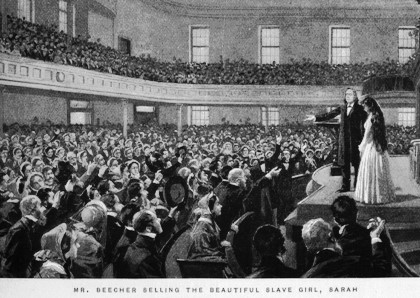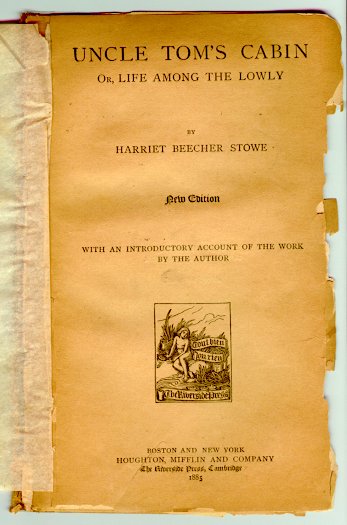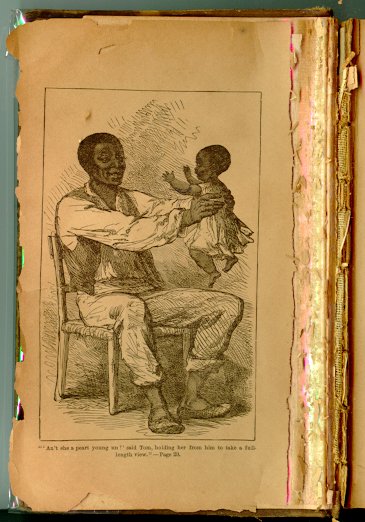Harriet Beecher Stowe
Today, a woman turns slavery from theoretical wrong into personal evil. The University of Houston's College of Engineering presents this series about the machines that make our civilization run, and the people whose ingenuity created them.
Harriet Beecher was her mother's 7th child. After the 9th, her mother died. Harriet was raised by her father, a Calvinist preacher in Connecticut who held forth on Hell and damnation, but denied the doctrine of predestination. When she was 22 they moved out to Cincinnati where he was to be President of a new seminary.
Her father had only one faculty member, a bright, pudgy, and ineffectual fellow named Calvin Stowe. For a while, Calvin's wife Eliza befriended Harriet Beecher. So when Eliza died young, Harriet and Calvin were drawn together by a shared loss, and in 1836 Harriet became Harriet Beecher Stowe. Their first children were twin girls whom they chose to name Harriet and Eliza.
Calvin was a piece of work. In a crisis, he simply went to bed. He had regular visions of ghosts. Still, an odd chemistry bound these two somewhat strange, and very plain, people. Maybe they were just easy on each other. When Harriet had had-it-up-to-here with bearing children and primitive life in early Cincinnati, she'd go East to take the water cure, leaving Calvin with the kids.
It was on such a trip, with hypochondriac Calvin promising to die before she returned, that Harriet fell in with organized anti-slavery forces. By then she'd already crossed the Ohio River into Kentucky and talked with slave women. A slave named Eliza Buck had touched her deeply with stories about the brutality of the system.
In 1850, Calvin moved to Bowdoin College in Maine. He sent Harriet ahead with the children to set up the house. She looked so frumpy when she got off the ferry that the college president, who'd come to meet her, went back saying she hadn't arrived. The only people who'd left the boat were a poor Irish woman and her brats!
Next spring, struggling with a cold damp house and one more baby, 40-year-old Harriet began writing Uncle Tom's Cabin. She'd written very little, and she set to work with few hopes.
But what she created was the literary success of the century. When people asked how she'd done it, she said God had written it for her. Some complained about the meanness of letting Little Eva die. She only replied that when she herself found out about that part, she was so devastated she had to quit writing for two weeks.
Uncle Tom's Cabin fulfilled no canon of literary greatness. It was poorly researched, to boot. But Harriet galvanized anti-slavery forces by humanizing abolitionist theory. Now slavery had faces and names (including that recurrent name Eliza). And when had a slave ever been the hero of a book? When Abe Lincoln, half-hearted abolitionist at best, received Harriet in the White House he said, "So this is the little woman who made this big war."
However, a more perceptive analysis of Harriet Beecher Stowe was made by George Sand in France. Stunned by the moral force of the book, she simply said that Stowe had "no talent, only genius."
I'm John Lienhard, at the University of Houston, where we're interested in the way inventive minds work.
(Theme music)
McCullough, D., Brave Companions: Portraits in History. New York: Touchstone, 1992, Chapter Three.
I am grateful to Dorothy Baker, UH English Department, for additional counsel and ideas.

Click on thumbnail to view the full-scale image
Harriet Beecher Stowe
For full size images of the pictures, click on the thumbnails above
Title page and frontispiece of a cheap 1885 edition of Uncle Tom's Cabin
(Wood pulp paper was at its worst then. We tell that story elsewhere.)

Harriet's brother, Henry Ward Beecher, was a theatrical abolitionist preacher. Here he is selling a slave girl at a church service to buy her freedom.
From the November, 1896, Scribner's Magazine

